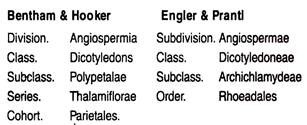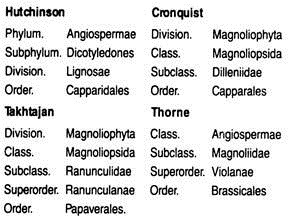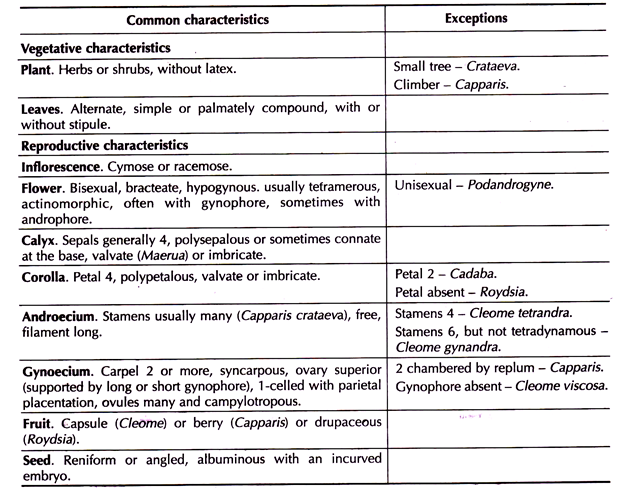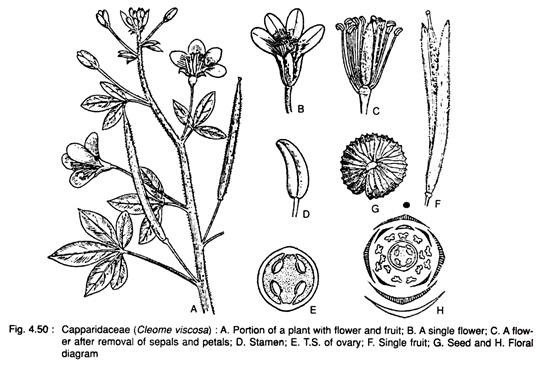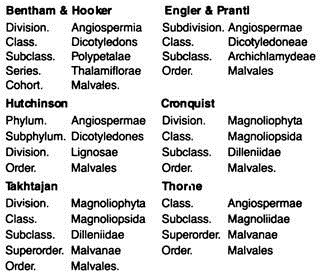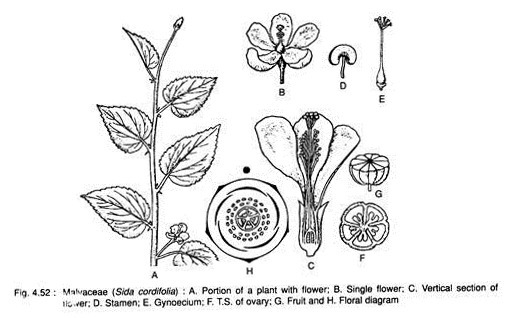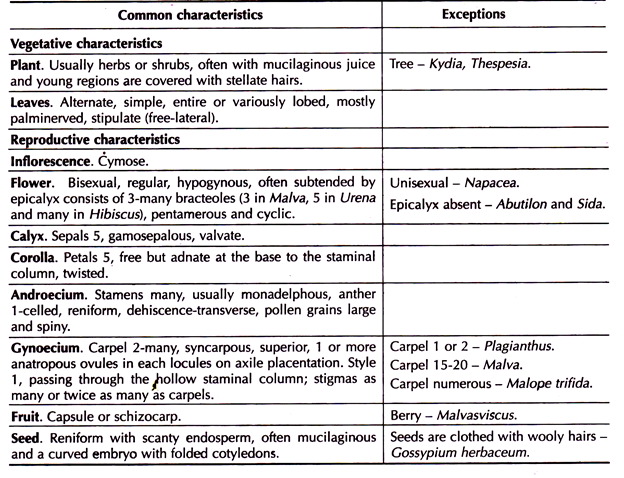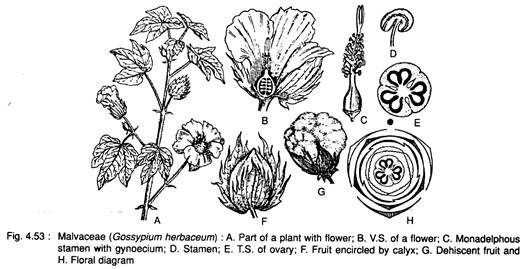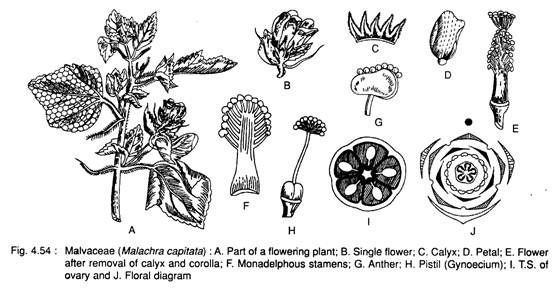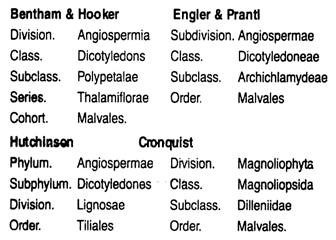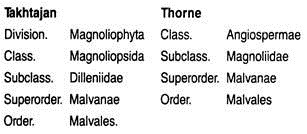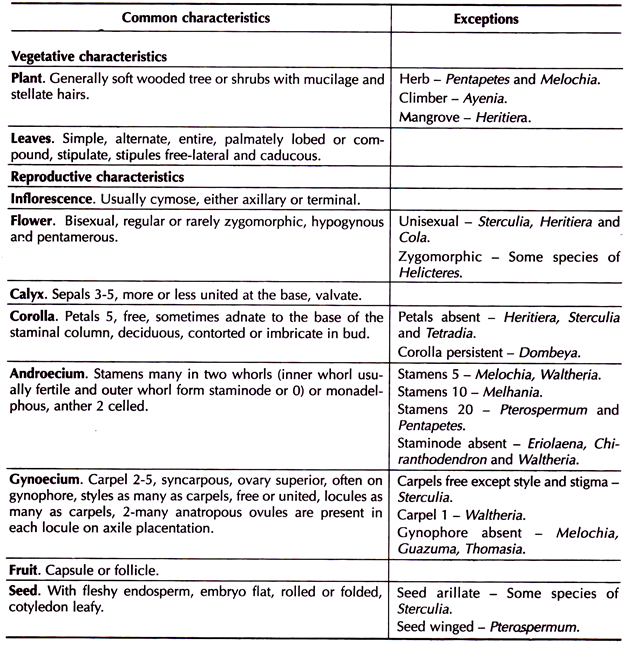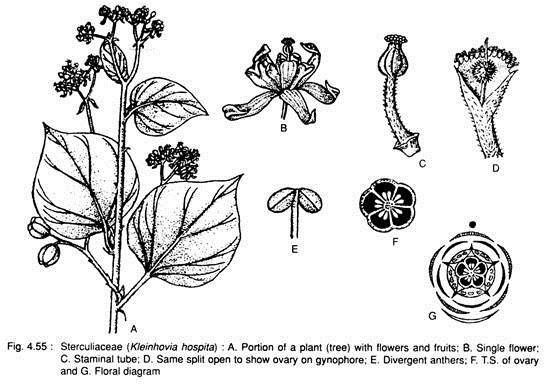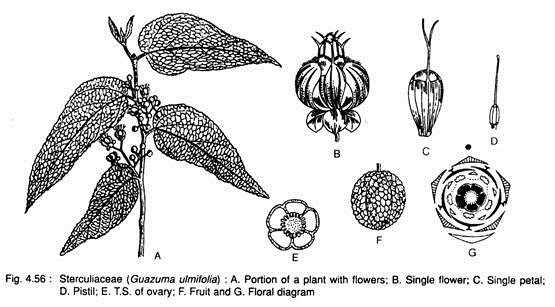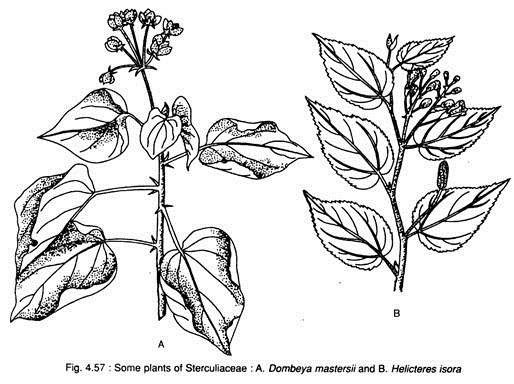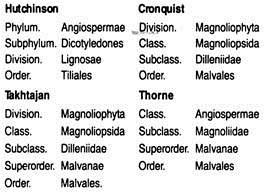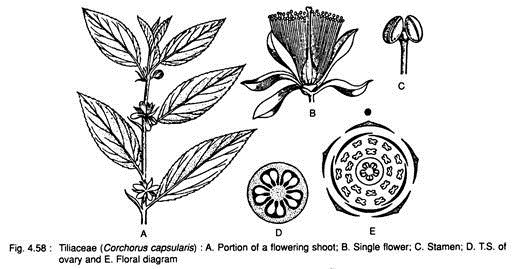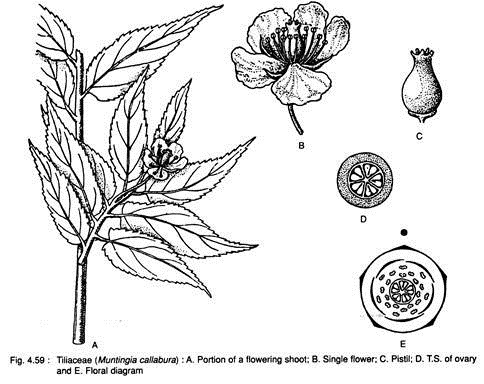Are you looking for an essay on ‘Dicotyledons’? Find paragraphs, long and short essays on ‘Dicotyledons’ especially written for school and college students.
Essay on Dicotyledons
Essay Contents:
- Essay on Capparidaceae (Caper Family)
- Essay on Malvaceae (Mallow Family)
- Essay on Sterculiaceae (Sterculia Family)
- Essay on Tiliaceae (Linden Family)
Essay # 1. Capparidaceae (Caper Family):
The family Capparidaceae is represented by 42 genera and more than 900 species found to grow in warm temperate and tropical region of the world. In India, 7 genera and about 53 species are available in southern and western part and also in some region of Himalayas.
The type genus of the family is Capparis.
Systematic Position:
Identifying Characteristics:
1. Plants are generally herbs.
2. Inflorescence racemose.
3. Flowers bisexual, hypogynous, regular (actinomorphic), tetramerous, bracteate, gynophore or gynandrophore often present.
4. Petals 4, free (corolla never cruciform).
5. Stamens 4 or indefinite, free.
6. Carpel usually 2, placentation parietal.
Floral Formula:
Capparidaceae: Distinctive Features:
Phylogeny and Systematic:
The family Capparidaceae is closely related to Cruciferae (Brassicaceae) and Papaveraceae. Like Cruciferae, Bentham and Hooker included the family Capparidaceae under the order Parietales; Engler and Prantl included under Rhoeadales and Hutchinson included under Capparales. Recent phylogenetists like Takhtajan, Cronquist and others also placed the family under the Capparales.
Bentham and Hooker (1862-67) divided the family into two tribes, Cleomeae and Cappareae. But Hutchinson (1967, 69) shifted Cleomeae from Capparidaceae and raised a new family Cleomaceae.
Common Plants:
1. Capparis spinosa L.;
2. Cleome gynandra L. (Syn. Gynandropsis gynandra Briq);
3. C. rutidospermum L.;
4. Crataeva nurvala Buch.-Ham. (Syn. C. religiosa Rorst. f.);
5. Cleome viscosa L. (Syn. Polanisia viscosa DC.) etc.
Key to Genera:
I. Fruit capsule; plants usually herbs.
1. Stamens 12 to 20, sessile; corolla imbricate in bud; leaves digitately compound. …. Cleome.
2. Stamens 6 on androphore, corolla open in bud; leaves compound, 5-7 foliate. …….Gynandropsis.
II. Fruit berry or capsule.
1. Disc present below sepaline tube; open in bud; plants usually small trees. …….Crataeva.
2. Disc hemispheric; sepals 4, 2-seriate; stamens 8 to numerous, long purple, inserted at the base of gynophore; plants climbing with spinous stipule……………… Capparis.
Plants of Economic Importance:
The plants of this family are not so economically important. Some are used as ornamental plants, medicines and other purposes.
A. Ornamental Plants:
Capparis spinosa L. (Caper plants), Cleome spinosa (Giant spider) and Crataeva adansonii DC. These are grown in the garden as ornamental plants.
B. Medicinal Plants:
1. The roots of Maerua arenaria HK. f. & Th. are used as tonic and also as stimulant.
2. The leaves and barks of Crataeva nurvala Buch.-Ham. (Syn. C. religiosa Forst. f. var. nurvala Buch.-Ham.)- are diuretic.
3. Cleome gynandra DC. (Syn. Gynandropsis pentaphylla L.). The seeds are internally employed to control round worms.
C. Other Plants:
1. The flower buds of Capparis spinosa L. are used in flavouring of foods.
2. Capparis decidua (Forsk.) Pax. (Syn. Capparis aphylla Roth.) and C. zeylanica L. (Syn. Capparis horrida L.) The fruits of these are used in pickles.
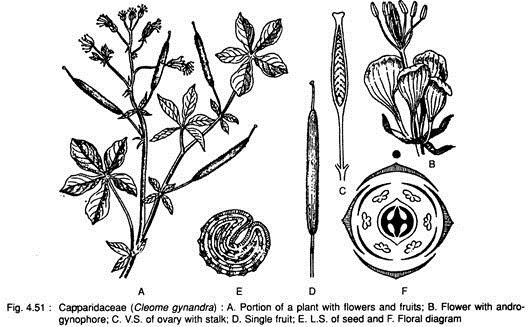
Cruciferae:
1. Plant:
Herb.
2. Leaves:
Simple, exstipulate, radicle or cauline, lyrate in shape.
3. Flowers:
Ebracteate (i.e. without bract), without androphore and gynophore.
4. Corolla:
Cruciform.
5. Androecium:
Stamens 6, tetradynamous (2 + 4).
6. Fruit:
Siliqua or silicula.
7. Endosperm:
Absent.
Capparidaceae:
1. Plant:
Herbs, shrubs or trees.
2. Leaves:
Simple or palmately compound, stipu late or exstipulate.
3. Flowers:
Bracteate, with gynophore, sometimes with both androphore and gynophore.
4. Corolla:
Never Cruciform.
5. Androecium:
Stamens few or many, never tetradynamous.
6. Fruit:
Various types: Siliqua, Berry, Capsule, Samara, Nut or Drupe.
7. Endosperm:
Absent or scanty.
Essay # 2. Malvaceae (Mallow Family):
The family Malvaceae is represented by 197 genera and 2,865 species, found to grow in the tropical and subtropical regions of the world. In India, there are 22 genera and about 110 species available in tropical regions.
The type genus of the family is Malva.
Systematic Position:
Identifying Characteristics:
1. Plants commonly herbs or shrubs, often mucilaginous and with stellate hairs on comparatively young region.
2. Leaves simple with free-lateral stipule.
3. Flower bisexual, sepals often with epicalyx; petals 5, twisted; stamens monadelphous, anther 1-celled.
4. Fruit capsule.
Floral Formula:
Malvaceae: Distinctive Features:
Phylogeny and Systematic:
Malvaceae family is closely related to other families of Malvales like Tiliaceae and Sterculiaceae.
Bentham and Hooker divided the Malvaceae into 4 subfamilies such as Malveae, Ureneae, Hibisceae and Bombaceae. The subfamily Bombaceae include the members with large trees, flowers bisexual — often appear before the leaves, leathery sepals, monadelphous or polydelphous stamens, hairy outgrowth on pericarp etc. Engler treated this tribe Bombaceae as a separate family.
Malvaceae is related to Tiliaceae and Sterculiaceae but differ in monothecous anther and staminal tube. Most of the taxonomists included it under Malvales along with Tiliaceae and Sterculiaceae. Hutchinson (1959, 69, 1973), however, retained only Malvaceae under the order Malvales and Sterculiaceae and Tiliaceae along with Bombacaceae, Gonystylaceae and Scytopetalaceae under a single order Tiliales.
Common Plants:
1. Abelmoschus esculentus (L.) Moench. (Syn. Hibiscus esculentus L.);
2. Abutilon indicum Don.;
3. Gossypium herbaceum L.;
4. Hibiscus mutabilis L.;
5. H. rosa-sinensis L.;
6. Malachra capitata L.;
7. Sida alba L. (Syn. S. spinosa L.);
8. S. cordifolia L.;
9. S. rhombifolia L.;
10. Thespesia populnea (L.) Soland. ex. Corr.;
11. Urena lobata L. etc.
Key to Genera:
1. Fruit capsular:
i. Stigma spreading and seeds reniform.
A. Ovary 3-celled……………. Kydia.
B. Ovary 5- celled…….. Hibiscus.
ii. Stigma cohering in club-shaped mass. Bracteoles (epicalyx) 3, large, cordate; seeds cottony. …. Thespesia.
2. Fruit of ripe carpels separating from the axis.
i. Styles as many as carpels:
A. Epicalyx absent, without false septum.
a. Ovules 2 or more, ascending, reniform. …. Abutilon.
b. Ovules solitary; flowers small. …… Sida.
B. Epicalyx of 3 distinct bracteoles.
a. Stigma capitate; carpels 8- 12. …… Malvastrum.
b. Stigmas linear, carpels numerous. ….. Malva.
C. Epicalyx of 6-9 bracteoles, united at the base. ….. Althaea.
ii. Styles twice as many as carpels:
a. Epicalyx present; carpels 10. ….. Malvaviscus.
b. Bracteoles 0 or mixed with flowers in dense heads; carpels unarmed. ………… Malachra.
c. Bracteoles 5; carpels opposite to petals. ….. Urena.
d. Bracteoles 10; carpels opposite to sepals. ….. Pavonia.
Genus – Sida:
Key to Species:
i. Carpels 5
a. Leaf base obtuse, apex acute………. acuta.
b. Leaf base cordate, apex acuminate. ……Cordata.
ii. Carpels 6-10
a. Leaves cordate; awns longer than calyx. …….. cordifolia.
b. Leaves rhomboid; awns shorter than calyx. ……… rhombifolia.
Plants of Economic Importance:
The members of this family are very much important as source of vegetables, fibres, oils, medicines and for their ornamental value.
A. Vegetables:
1. Abelmoschus esculentus (L.) Moench. (Ladies finger). The young fruits are used as vegetable.
2. Hibiscus mutabilis (Cotton rose).
3. H. rosa-sinensis (China-rose).
4. H. sabdariffa (Jamaica sorell).
5. H. syriacus (Rose-of-Sharon).
6. Malva sylvestris (Mallow).
7. Thespesia populnea (Indian tulip tree).
F. Other Uses:
1. Pavonia odorata. The roots are used in perfumery.
B. Fibres:
Many members of this family are important as good source of fibre.
The names of some important fibre yielding plants are given:
1. Gossypium herbaceum and G. arboretum in India and other countries and G. hirsutum and G. barbadense grown in America. The seeds are covered with long hairs (cotton fibre). The cotton is used very commonly in textiles.
2. Hibiscus cannabinus (Patsan). The cortical fibres of the plants are widely used for ropes, floor coverings, coarse sackings etc.
3. Sida cordifolia, S. acuta, S. rhombifolia; Abutilon indicum, A. polyandrum; Tbespesia lampas, Malachra capitata etc. These plants yield fibres of inferior quality.
C. Oils:
1. Gossypium herbaceum and other species. The seeds are the source of fatty oil which is edible. The oil is also used as lubricant, manufacture of soaps, etc. The oil cake is used as cattle feed.
2. Hibiscus cannabinus L. (Patsan). The seeds are also the source of fatty oil. The oil is used as vegetable oil and also as a lubricant in the preparation of varnishes and linoleum paints.
D. Medicines:
1. Urena lobata L. The barks and roots are used as a cure of hydrophobia.
2. Malachra capitata L. The roots are used in the treatment of rheumatism.
3. Malva verticillata L. The roots are used for whooping cough. The ash of dried leaf is used on scabies.
E. Ornamental Plants:
Different species of Malvaceae are grown in the garden for their large and showy flowers.
Some of them are:
1. Althea rosea (Hollyhock).
2. Thespesia populnea (Indian tulip tree), and Kydia calycina (Pula). The timber of these plants is used in making toys, pencils, match factory and in agricultural implements.
Essay # 3. Sterculiaceae (Sterculia Family) :
The family Sterculiaceae is represented by 60 genera and 700 species, found to grow mainly in the tropical regions of both northern and southern hemisphere of the world. In India, there are 18 genera and more than 90 species available mostly in tropical regions. A few species are also available in Himalayas.
The type genus of the family is Sterculia.
Systematic Position:
Identifying Characteristics:
1. Plants with fibrous stem, mucilaginous sac and stellate hairs.
2. Inflorescence generally cymose or paniculate cyme.
3. Flower bisexual or rarely unisexual, actinomorphic.
4. Sepals 5, valvate.
5. Petals 5, imbricate.
6. Stamens in two whorls (outer whorl staminodial or absent), monadelphous, anther 2-celled.
7. Ovary 5-chambered, often stalked.
8. Fruit capsule.
Sterculiaceae: Distinctive Features:
Floral Formula:
Phylogeny and Systematic:
The family Sterculiaceae is very close to Malvaceae and Euphorbiaceae.
Sterculiaceae is related to Tiliaceae and Malvaceae. The Malvaceae makes difference with others by having monothecous anther and staminal tube. Most of the taxonomists included it under Malvales along with Tiliaceae and Malvaceae.
Hutchinson (1959, 69, 73), however, retained only Malvaceae under the order Malvales and Sterculiaceae and Tiliaceae along with Bombacaceae, Gonystylaceae and Scytopetalaceae under a single order Tiliales.
Common Plants:
1. Abroma augusta L. f.;
2. Dombeya mastersii Gaertn.;
3. Guazuma ulmifolia Lamk. var. tomentosa K. schum. (Syn. Guazuma tomen- tosa Kunth.);
4. Heritiera fomes Buch. – Ham. (Syn. H. minor Roxb.);
5. Melochia corchorifolia L.;
6. Pentapetes phoenicea L.;
7. Sterculia alata Roxb.;
8. S. foetida L.;
9. Kleinhovia hospita L. etc.
Key to Genera:
I. Flowers bisexual:
1. Petals flat, deciduous; anthers alternating with staminodes …
i. Leaves oblique below; ovary at the base of the staminal column; anther- cells parallel; seeds winged. ………… Pterospermum.
ii. Leaves simple; ovary at the top of the staminal column; anther-cells divaricate; capsule woody with wingless seed. ….. Helicteres.
2. Petals flat, persistent; anthers alternating with staminodes …
i. Ovary 5-celled; styles 5. … Melochia.
ii. Ovary 1-celled, monocarpellary……. Waltheria.
iii. 15 anthers in 5 groups of 3, alternating with staminodes. … Pentapetes.
3. Petals deciduous, unequal; capsule, inflated pyriform. …… Kleinhovia.
4. Petals concave; anthers in groups between each pair of staminodes…
i. Petals clawed; fruit membranous; 5- angled 5-winged capsule, truncated above; ovules many in each loculus. ………………… Abroma.
ii. Fruits woody, tubercled capsule, globose; ovules many in each loculus. ………………..Guazuma.
iii. Petals ligulate; fruit armed, prickly or bristly capsule; ovules 2 in each loculus. ……………………. Buettneria.
II. Flower unisexual or polygamous; petals 0:
1. Staminal column with ring of sessile anthers…
i. Anthers 5; ripe carpels indehiscent. ……………Heritiera.
ii. Anthers 5-25; ripe carpels dehiscent. ……………..Sterculia.
Plants of Economic Importance:
Economically, the family is very important at different aspects:
A. Medicines:
1. Eriolaena Quinquelocularis:
The thick extract of the roots used as poultice (a soft composition applied in a cloth to sores) on the wounded area.
2. Guazuma Ulmifolia:
The roasted seeds have the property of astringency (to bind together) and used in diarrhoea.
3. Helicteres Isora (Marorphali):
The juice extracted from the roots is used to control diabetes.
4. Heritiera Littoralis:
The extract from seeds is used for the treatment of dysentery and diarrhoea.
5. Sterculia Balanghas:
The fruits are used as laxative.
B. Timber:
1. Eriolaena candollei, Heritiera littoralis, Pterospermum acerifolium, P. diversifolium, Sterculia villosa, S. foetida and 5. urens. The timber of the above plants are used in the preparation of toys, furniture, match box, tea box, construction works, etc.
C. Fibre:
1. Abroma augusta, Eriolaena hookeriana, Guazuma ulmifolia, Helicteres isora, Pterygota alata, Sterculia villosa, S. guttata and 5. balanghas. The fibres extracted from the bark of the above plants are used in the preparation of cord (a short thin rope).
D. Beverages:
1. Cola acuminata (Kola nut). The seeds contain significant amount of theobromine and caffeine, used in soft drinks and beverages.
2. Theobroma cacao (Cocoa tree). Cocoa powder is prepared from roasted seeds and is used in chocolate and beverage.
E. Ornamental Plants:
The following plants are cultivated for ornamentation and also as avenue trees:
1. Dombeya natalensis and D. spectabilis.
2. Guazuma ulmifolia
3. Pentapetes phoenicea (Dophariya). Herb with red flowers which open at noon.
4. Pterospermum acerifolium (Kanak champa)
5. Sterculia balanghas, S. alata, S. foetida and S. parviflora.
F. Other Uses:
1. Guazuma ulmifolia and Sterculia villosa. The leaves of the plants are used as fodder.
2. Sterculia urens. Karaya gum is collected from this plant. It is used in leather, paper and textile industry. It is also used in pharmaceuticals.
Essay # 4. Tiliaceae (Linden Family) :
The family Tiliaceae is represented by 62 genera and 800 species, found to grow in the tropical and temperate regions of the world. The plants mainly grow in Brazil and South East region of Asia. In India, 14 genera and 110 species of this family is found mostly in the warmer regions.
The type genus of the family is Tilia.
Systematic Position:
1. Stem fibrous, mucilaginous and hairy.
2. Leaves simple, alternate and stipulate
3. Inflorescence axillary or terminat cymose of few- to many-flowered.
4. Flower commonly bisexual, hypogynous, regular (actinomorphic),
5. Stamens 10 – indefinite, free or connate at the base. Anthers dithecous (2- celled).
6. Fruit capsule or berry-like, dehiscent or indehiscent.
IFloral Formula:
Tiliaceae: Distinctive Features:
Phylogeny and Systematic:
The family is closely related to Malvaceae and Sterculiaceae.
Bentham and Hooker placed it in Malvales of series Thalam,florae, subclass Polypetalae under the class Dicotyledons. Engler and Prantl placed the family under Malvales, subclass Archichlamydeae and class Dicotyledoneae. Recent taxonomists like Takhtajan (1969, 80) and Cronquist (1968, 81) followed Engler and included Elaeocarpus and some closely related genera in the family Elaeocarpaceae.
Common Plants:
1. Brownlowia lanceolata Benth.;
2. Corchorus aestuans L. (Nalte sak);
3. C. capsularis L. (Jute);
4. C. olitorius L. (Jute);
5. Elaeocarpus floribundus BI.;
6. E. ganitrus Roxb. (Rudraksha);
7. Grewia subinaequalis DC. (Syn. G. asiatica Masters non Linn.);
8. Microcos paniculata L. (Syn. Grewia micro- cos L.);
9. Muntingia callabura L.;
10. Triumfetta rhomboidea Jacq.
Key to Genera:
I. Sepals free.
1. Petals not clawed or glandular.
i. Fruits many-seeded capsule; plant usually herb. …………… Corchorus.
ii. Fruit fleshy drupe; plant tree or shrub. ……………….. Elaeocarpus.
2. Petals with thickened or glandular claw.
i. Fruit smooth, drupaceous; leaves 3-9 nerved. ……………… Grewia.
ii. Fruit prickly, globose, indehiscent or separating into 3-5 cocci…………………….. Triumfetta.
II. Sepals united into cup.
1. Anther cells confluent; staminodes present in the inner whorl. ………………… Brownlowia.
2. Stamens on a short axis; staminodes absent. ………………… Berrya.
Plants of Economic Importance:
The members of this family are useful in the production of fibres, timbers, fruits, medicines and in gardens.
A. Fibres:
1. Corchorus olitorius L. and C. capsularis L. Both the plants are useful in the production of fibre (bast fibre), used for making carpets, bunny bags, twins etc.
2. Erinocarpus sp., Triumfetta sp., Berrya sp. and Grewia sp. The bark of the above plants yields fibre used for making ropes etc.
B. Timbers:
Grewia elastica, G. tiliaefolia, G. sclerophylla, Berrya cordifolia, Elaeocarpus ganitrus, Tilia vulgaris etc. The timber of the above plants is used for various purposes.
C. Ornamental Plants:
Muntingia calabura, Elaeocarpus ganitrus, Grewia elastica, G. tiliaefolia, G. serrulata, Tilia vulgaris are cultivated as ornamental plants.
D. Fruits:
The fruits of Grewia subinaequalis (Phalsa) and its other species are edible.
E. Medicines:
1. Plants of Triumfetta rhomboidea is used to control gonorrhoea.
2. Roots of Grewia vallosa is used to condiarr diarrhea.
3. Roots of Grewia sclerophylla is used to control intestine irritation and cough.
4. Plants of Microcos paniculata are used to control itch and eczema.
5. Bark of Grewia tiliaefolia is used to control dysentery.
F. Other Uses:
1. As Fodder:
The young twigs and also the leaves of Grewia glabra, G. tenax and some other species are used as food for goats, camels etc.
2. In Lac Culture:
The young leaves and twigs of Grewia glabra and G. serrulata are used to feed insect in lac culture. 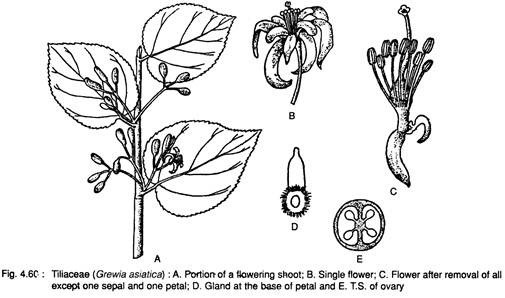
Malvaceae:
1. Plant:
Usually herbs or shrubs, often with mucilage.
2. Leaves:
Alternate, simple, stipulate, margin entire or variously lobed.
3. Flowers:
Regular, bisexual.
4. Calyx:
Sepals-5, usually surrounded by epicalyx.
5. Corolla:
Petals-5, almost free; twisted aestivation.
6. Androecium:
Stamens many, usually monadelphous.
7. Anthers:
1-celled, reniform.
8. Gynoecium:
Carpels- 2 to many.
Ovary 2-many celled with one to many anatropous ovules in each cell
9. Fruit:
Capsule or schizocarp.
Sterculiaceae:
1. Plant:
Usually trees or shrubs, sometimes herbs.
2. Leaves:
Alternate, simple or palmately compound, stipulate, margin lobed or entire.
3. Flowers:
Regular or irregular, bisexual or unisexual.
4. Calyx:
Sepals 3-5, free or slightly united at the base.
5. Corolla:
Petals-5, sometimes 0; twisted aestivation.
6. Androecium:
Stamens many in 2 whorls, outer whorl staminodal or 0, but the inner whorl is fertile or monadelphous.
7. Anthers:
2-celled.
8. Gynoecium:
Carpels-4 to 5.
Ovary often stalked, 5 celled with 2-many anatropous ovules in each cell on axile placentation.
9. Fruit:
Capsule or follicle.
Tiliaceae:
1. Plant:
Usually shrubs or trees, sometimes herbs.
2. Leaves:
Alternate, simple, stipulate, margin entire, lobed or dentate.
3. Flowers:
Regular, bisexual or unisexual.
4. Calyx:
Sepals-5, free or united.
5. Corolla:
Petals-5 or less or sometimes 0; imbricate aestivation.
6. Androecium:
Stamens 10-many, free or slightly united or polydel- phous; rarely situated on an androgynophore.
7. Anthers:
2-celled.
8. Gynoecium:
Carpel-1 to 5.
Ovary 2-10 celled with 1- many pendulous or ascending ovule in each cell.
9. Fruit:
Capsule.
